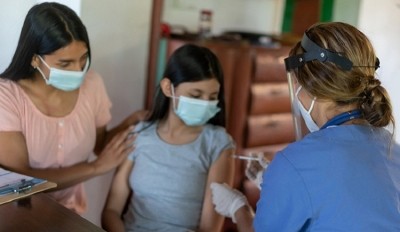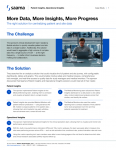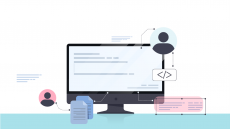From hesitancy to reliance: journey to real-world data acceptance

In previous years, real-world data (RWD) and real-world evidence (RWE) have proven useful, yet there still existed a certain degree of reluctance to use those tools. Karen Ooms, executive vice president and head of statistics with Quanticate, discussed RWD and RWE with Outsourcing-Pharma, including their benefits of use, reasons why some trial professionals have been reluctant to jump in, and why researchers should embrace them.
OSP: Could you please tell us a little bit about real-world data, and how the use and acceptance of RWD have evolved in recent years?
KO: RWD is observational data and is exactly what it says on the tin, data from the real world. What this means in drug development is that the data has come from outside a randomized clinical trial (RCT) setting. RCTs are the traditional way to collect trial data to analyze for an investigational medicinal product (IMP).
RWD has grown in acceptance and there are a couple of reasons for this, one is that some argue that RWD provides valuable insight into how an IMP performs in the real world, whereas a RCT setting is heavily regulatory and robustly follows the patient inclusion and exclusion criteria defined in a protocol and trial settings. RWD can provide insight that you simply would not get in the traditional sense, and this insight is worth reviewing and not ignoring.
The second reason is that advances in technology have enabled so much additional data to be collected, wearable devices, mobile apps, and other data capture methods have strengthened the use case for collecting RWD because it’s easier to collect, and more data can be collected, there have also been advances in the access in patient register databases which is a big source of RWD and all this additional data give more insight into the safety and efficacy profile of an IMP.
We have seen this acceptance of RWD in recent years when in 2019, Pfizer had the iBRANCE approval that was largely based on analysis from RWD.
OSP: What are the pros and cons of using RWD in clinical trials?
KO: The advantages of RWD as mentioned is that it gives insight into the investigational drug’s performance in a real-world setting: It also can give you more insight into how an IMP would react with other con-medication and treatments because you will get more situations where the trial drug is being taken alongside other medications.
Another advantage of RWD is the ability to help influence early approvals but with data still being able to be collected to determine the efficacy and safety of a drug, such as the COVID-19 vaccines. Also, RWD allows us to see the ongoing efficacy and safety profile of drugs that are already approved if we choose to continue to analyze approved drugs.
There have been some reasons for hesitancy with RWD. Some argue that the data from the real world cannot be as easily trusted because there are too many variables that cannot be controlled, unlike a traditional clinical trial with patient screening and recruitment processes and easily controlled dosage, etc.
It is sometimes difficult to unravel the data to determine whether the IMP was the cause of a patient’s improvement or not. For example, if a clinician can choose which treatment to give, they may decide to give the new unproven drug to a really poorly patient, and the standard drug to a less poorly patient, because there is less risk in both situations. But in these situations, it will be more difficult to detect that the new drug performs better than the standard one due to the differences in the underlying health of the patients.
Some statisticians argue that with almost a limitless amount of data you can get lost in doing over-analysis as you hope to find answers you want to see but may not see and can over-analyze, so it has to be careful of defining how much RWD is being used and being strict in the analysis you do perform.
OSP: Same question, but with RWE: how has use and understanding evolved?
KO: RWE is obtained from the analysis of RWD. There are many ways that this has evolved such as the use of large, pragmatic, and simple trials where RWD are collected, or the use as external control data for a single-arm trial conducted in a rare disease of an unmet need where it is unethical to not give a new treatment to a patient.
OSP: What are the advantages of using RWE, and reasons organizations might be hesitant to put it to use?
KO: Although the 21st Century Cures Act (passed in 2016) placed additional focus on the use of RWD to support regulatory decision making, including approval of new indications for approved drugs some companies are hesitant to make use of these data. This is because they are worried that the evidence included will not be considered by the FDA or other regulatory agencies.
However, the FDA actively encourages more use of this type of evidence to support study objectives and has issued draft guidance to help companies submit documents that make use of RWD and RWE.
OSP: How has the COVID-19 pandemic caused the use of RWD to increase? Why has its use proven helpful in overcoming challenges caused (or exacerbated) by the pandemic?
KO: As mentioned RWD has increased significantly during the COVID-19 pandemic. This is because the clinical trials for the vaccines were done against the very original variant of COVID that was first discovered in Wuhan. The genetics for this virus was shared with the larger scientific community so drug developers could start designing and building their drugs.
As COVID spread, more variants emerged with new mutants and different genetic makeup; however the vaccines in the RCT setting have not been used on these new mutants, but by using RWD you can build a picture of how effective the vaccines are at the new variants which haven’t been analyzed in a clinical trial setting, but instead a real-world setting.
OSP: What advice do you have for sites and sponsors who haven’t turned to RWD/RWE or are just getting started?
KO: Clearly define your use case for RWD and be strict with the analysis that you define so that you do not get lost in over-analysis of RWD. Document your data sources carefully – noting the date of access too. When planning the analyses consider the type of bias that may influence the results and try to include demographic and baseline data that may mitigate against the bias introduced from analyzing real-world data. A friendly statistician could be helpful to do this with you.
OSP: Do you have anything to add?
KO: Right now we are using RWD to see the impact of the COVID vaccination roll-out on new COVID cases, hospitalizations, and deaths and SAGE will use these data to provide real world evidence to the government to help them decide whether the UK can stop our social distancing practices in July. And everyone is waiting with bated breath to see what will happen.




















